一、知识点准备
1.1 什么是依赖传递?
我们只添加一个struts2-core的依赖,结果会发现所有关于struts2的依赖都进来了。
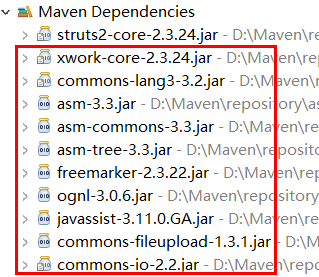
因为我们的项目依赖struts2-core-2.3.24.jar,而struts2-core-2.3.24.jar会依赖xwork-core-2.3.24.jar等等,所以xwork-core-2.3.24.jar等jar包也出现在我们的maven工程中,这种现象我们称为依赖传递。从下图可以看到他们的关系:
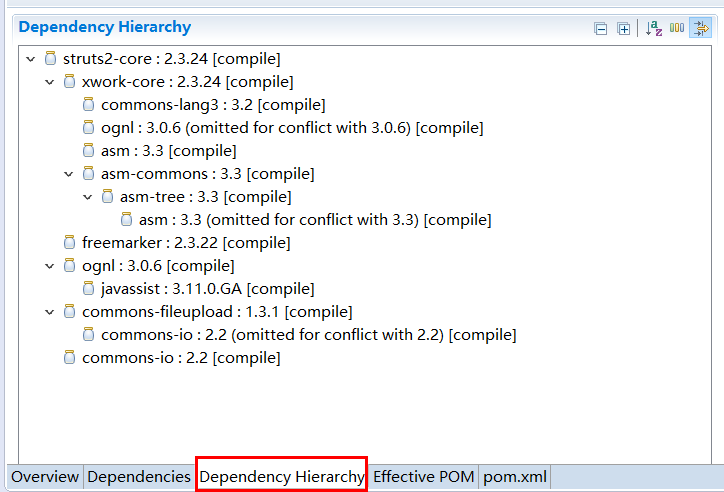
1.2 依赖版本冲突的解决
接着添加两个依赖
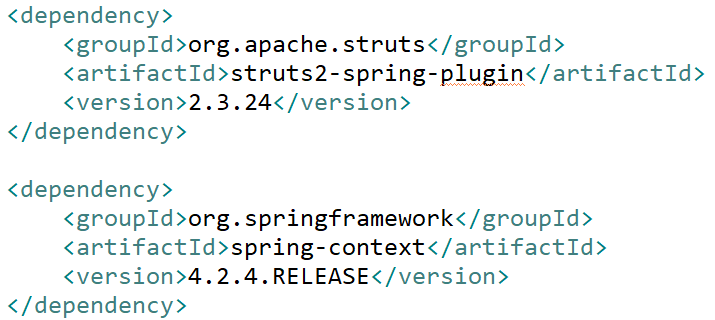
我们发现这两个jar包同时依赖了spring-beans
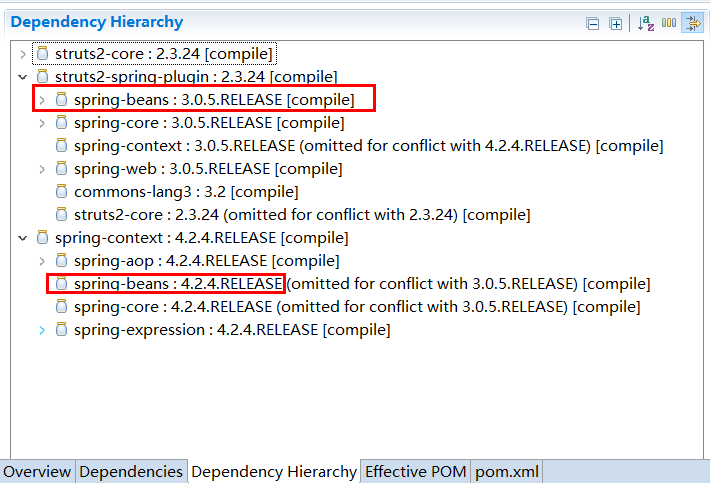
struts2-spring-plugin依赖spring-beans-3.0.5,spring-context依赖spring-beans-4.2.4,但是发现spring-beans-3.0.5加入到工程中了,而我们希望spring-beans-4.2.4加入到工程,这就造成了依赖冲突。解决依赖冲突有以下原则:
- 第一声明者优先原则(需要用的放在前面)
在pom文件定义依赖,以先声明的依赖为准。
测试:如果将上面struts2-spring-plugin和spring-context顺序颠倒,系统将导入spring-beans-4.2.4。
分析:由于spring-context在前边,以spring-context依赖的spring-beans-4.2.4为准,所以最终spring-beans-4.2.4添加到了工程中。
- 路径近者优先原则(自己添加jar包)
例如:A依赖spring-beans-4.2.4,A也依赖B,其中B依赖spring-beans-3.0.5,那么spring-beans-4.2.4会优先被依赖在A中,因为spring-beans-4.2.4相对spring-beans-3.0.5被A依赖的路劲最近。
测试:在本工程中的pom文件加入赖spring-beans-4.2.4的依赖,根据路径近者优先原则,系统将导入spring-beans-4.2.4:
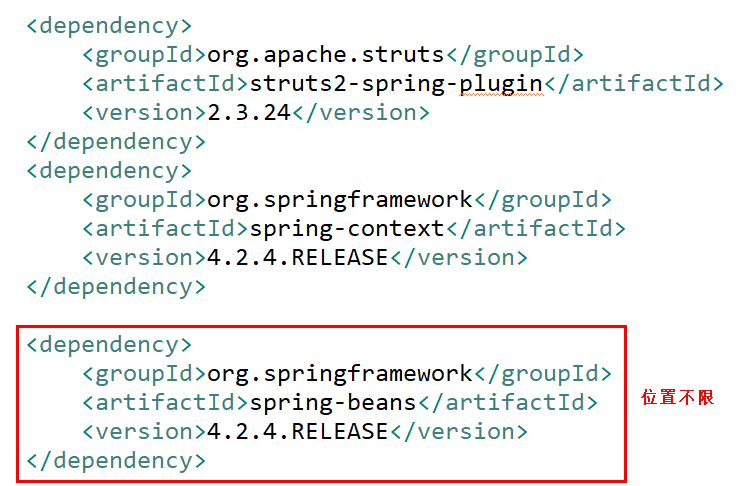
- 排除依赖原则
比如在依赖struts2-spring-plugin的设置中添加排除依赖,排除spring-beans

- 版本锁定原则
面对众多依赖,我们可以采用直接锁定版本的方法确定依赖构件的版本,版本锁定后则不用考虑依赖的声明顺序或依赖的路径,以锁定的版本为准添加到工程中,此方法在企业开发中最常用。
如下的配置是锁定了spring-beans和spring-context的版本
<dependencyManagement> <dependencies> <!-- 这里锁定版本为4.2.4 --> <dependency> <groupId>org.springframework</groupId> <artifactId>spring-beans</artifactId> <version>4.2.4.RELEASE</version> </dependency> <dependency> <groupId>org.springframework</groupId> <artifactId>spring-context</artifactId> <version>4.2.4.RELEASE</version> </dependency> </dependencies> </dependencyManagement>
注意:在工程中锁定依赖的版本并不代表在工程中添加了依赖,如果工程需要添加锁定版本的依赖则需要单独添加<dependencies></dependencies>标签,如下:
<dependencies> <!-- 这里是添加依赖 --> <dependency> <groupId>org.springframework</groupId> <artifactId>spring-beans</artifactId> </dependency> <dependency> <groupId>org.springframework</groupId> <artifactId>spring-context</artifactId> </dependency> </dependencies>
上边添加的依赖并没有指定版本,原因是已在<dependencyManagement>中锁定了版本,所以在<dependency>下不需要再指定版本。
二、构建项目
2.1 创建一个maven工程
打包类型为war
2.2 添加web.xml文件
右键工程 --> Java EE Tools --> Generate Deployment Descriptor Stub
2.3 定义pom.xml
maven工程首先要识别依赖,web工程实现SSH整合,需要依赖struts2.3.24、spring4.2.4、hibernate5.0.7等,在pom.xml添加工程如下依赖:(在实际企业开发中会有架构师专门来编写pom.xml)
分两步:1、锁定依赖版本;2、添加依赖
<!-- 属性 --> <properties> <spring.version>4.2.4.RELEASE</spring.version> <hibernate.version>5.0.7.Final</hibernate.version> <struts.version>2.3.24</struts.version> </properties> <!-- 锁定版本,struts2-2.3.24、spring4.2.4、hibernate5.0.7 --> <dependencyManagement> <dependencies> <dependency> <groupId>org.springframework</groupId> <artifactId>spring-context</artifactId> <version>${spring.version}</version> </dependency> <dependency> <groupId>org.springframework</groupId> <artifactId>spring-aspects</artifactId> <version>${spring.version}</version> </dependency> <dependency> <groupId>org.springframework</groupId> <artifactId>spring-orm</artifactId> <version>${spring.version}</version> </dependency> <dependency> <groupId>org.springframework</groupId> <artifactId>spring-test</artifactId> <version>${spring.version}</version> </dependency> <dependency> <groupId>org.springframework</groupId> <artifactId>spring-web</artifactId> <version>${spring.version}</version> </dependency> <dependency> <groupId>org.hibernate</groupId> <artifactId>hibernate-core</artifactId> <version>${hibernate.version}</version> </dependency> <dependency> <groupId>org.apache.struts</groupId> <artifactId>struts2-core</artifactId> <version>${struts.version}</version> </dependency> <dependency> <groupId>org.apache.struts</groupId> <artifactId>struts2-spring-plugin</artifactId> <version>${struts.version}</version> </dependency> </dependencies> </dependencyManagement> <!-- 依赖管理 --> <dependencies> <!-- spring --> <dependency> <groupId>org.springframework</groupId> <artifactId>spring-context</artifactId> </dependency> <dependency> <groupId>org.springframework</groupId> <artifactId>spring-aspects</artifactId> </dependency> <dependency> <groupId>org.springframework</groupId> <artifactId>spring-orm</artifactId> </dependency> <dependency> <groupId>org.springframework</groupId> <artifactId>spring-test</artifactId> </dependency> <dependency> <groupId>org.springframework</groupId> <artifactId>spring-web</artifactId> </dependency> <!-- hibernate --> <dependency> <groupId>org.hibernate</groupId> <artifactId>hibernate-core</artifactId> </dependency> <!-- 数据库驱动 --> <dependency> <groupId>mysql</groupId> <artifactId>mysql-connector-java</artifactId> <version>5.1.6</version> <scope>runtime</scope> </dependency> <!-- c3p0 --> <dependency> <groupId>c3p0</groupId> <artifactId>c3p0</artifactId> <version>0.9.1.2</version> </dependency> <!-- 导入 struts2 --> <dependency> <groupId>org.apache.struts</groupId> <artifactId>struts2-core</artifactId> </dependency> <dependency> <groupId>org.apache.struts</groupId> <artifactId>struts2-spring-plugin</artifactId> </dependency> <!-- servlet jsp --> <dependency> <groupId>javax.servlet</groupId> <artifactId>servlet-api</artifactId> <version>2.5</version> <scope>provided</scope> </dependency> <dependency> <groupId>javax.servlet</groupId> <artifactId>jsp-api</artifactId> <version>2.0</version> <scope>provided</scope> </dependency> <!-- 日志 --> <dependency> <groupId>org.slf4j</groupId> <artifactId>slf4j-log4j12</artifactId> <version>1.7.2</version> </dependency> <!-- junit --> <dependency> <groupId>junit</groupId> <artifactId>junit</artifactId> <version>4.9</version> <scope>test</scope> </dependency> <!-- jstl --> <dependency> <groupId>javax.servlet</groupId> <artifactId>jstl</artifactId> <version>1.2</version> </dependency> </dependencies> <build> <plugins> <!-- 设置编译版本为1.7 --> <plugin> <groupId>org.apache.maven.plugins</groupId> <artifactId>maven-compiler-plugin</artifactId> <configuration> <source>1.7</source> <target>1.7</target> <encoding>UTF-8</encoding> </configuration> </plugin> <!-- maven内置 的tomcat6插件 --> <plugin> <groupId>org.codehaus.mojo</groupId> <artifactId>tomcat-maven-plugin</artifactId> <version>1.1</version> <configuration> <!-- 可以灵活配置工程路径 --> <path>/ssh</path> <!-- 可以灵活配置端口号 --> <port>8080</port> </configuration> </plugin> </plugins> </build>
2.4 准备数据库环境

2.5 配置文件
将配置文件放到 src/main/resources目录中
- hibernate.cfg.xml
<?xml version='1.0' encoding='utf-8'?> <!DOCTYPE hibernate-configuration PUBLIC "-//Hibernate/Hibernate Configuration DTD 3.0//EN" "http://www.hibernate.org/dtd/hibernate-configuration-3.0.dtd"> <hibernate-configuration> <!-- 会话工厂 --> <session-factory> <!-- 数据库方言,根据数据库选择 --> <property name="hibernate.dialect">org.hibernate.dialect.MySQL5Dialect</property> <!--为了方便调试是否在运行hibernate时在日志中输出sql语句 --> <property name="hibernate.show_sql">true</property> <!-- 是否对日志中输出的sql语句进行格式化 --> <property name="hibernate.format_sql">true</property> <property name="hibernate.hbm2ddl.auto">update</property> <!-- 加载映射文件 --> <mapping resource="cn/itcast/entity/Customer.hbm.xml"/> </session-factory> </hibernate-configuration>
- applicationContext.xml
<beans xmlns="http://www.springframework.org/schema/beans" xmlns:xsi="http://www.w3.org/2001/XMLSchema-instance" xmlns:context="http://www.springframework.org/schema/context" xmlns:aop="http://www.springframework.org/schema/aop" xmlns:tx="http://www.springframework.org/schema/tx" xsi:schemaLocation="http://www.springframework.org/schema/beans http://www.springframework.org/schema/beans/spring-beans.xsd http://www.springframework.org/schema/context http://www.springframework.org/schema/context/spring-context.xsd http://www.springframework.org/schema/aop http://www.springframework.org/schema/aop/spring-aop.xsd http://www.springframework.org/schema/tx http://www.springframework.org/schema/tx/spring-tx.xsd"> <!-- 数据库连接池 --> <bean id="dataSource" class="com.mchange.v2.c3p0.ComboPooledDataSource"> <property name="driverClass" value="com.mysql.jdbc.Driver" /> <property name="jdbcUrl" value="jdbc:mysql://localhost:3306/maven" /> <property name="user" value="root" /> <property name="password" value="root" /> </bean> <!-- 配置sessionFactory --> <bean id="sessionFactory" class="org.springframework.orm.hibernate5.LocalSessionFactoryBean"> <!-- 依赖dataSource --> <property name="dataSource" ref="dataSource"/> <!-- 创建工厂需要加载hibernate映射文件 --> <property name="configLocations" value="classpath:hibernate.cfg.xml"></property> </bean> </beans>
- Customer.hbm.xml
<?xml version="1.0"?> <!DOCTYPE hibernate-mapping PUBLIC "-//Hibernate/Hibernate Mapping DTD 3.0//EN" "http://www.hibernate.org/dtd/hibernate-mapping-3.0.dtd"> <!-- Generated 2016-2-26 16:58:40 by Hibernate Tools 4.3.1.Final --> <hibernate-mapping> <class name="cn.itcast.entity.Customer" table="cst_customer" optimistic-lock="version"> <id name="custId" type="java.lang.Long"> <column name="cust_id" /> <generator class="identity" /> </id> <property name="custName" type="string"> <column name="cust_name" length="32" not-null="true"></column> </property> <property name="custUserId" type="java.lang.Long"> <column name="cust_user_id"></column> </property> <property name="custCreateId" type="java.lang.Long"> <column name="cust_create_id"></column> </property> <property name="custIndustry" type="string"> <column name="cust_industry" length="32"></column> </property> <property name="custLevel" type="string"> <column name="cust_level" length="32"></column> </property> <property name="custLinkman" type="string"> <column name="cust_linkman" length="64"></column> </property> <property name="custPhone" type="string"> <column name="cust_phone" length="64"></column> </property> <property name="custMobile" type="string"> <column name="cust_mobile" length="16"></column> </property> </class> </hibernate-mapping>
- struts.xml
<?xml version="1.0" encoding="UTF-8"?> <!DOCTYPE struts PUBLIC "-//Apache Software Foundation//DTD Struts Configuration 2.3//EN" "http://struts.apache.org/dtds/struts-2.3.dtd"> <struts> <!-- 配置常量 --> <!-- 字符集 --> <constant name="struts.i18n.encoding" value="UTF-8"></constant> <!-- 开发模式 --> <constant name="struts.devMode" value="true"></constant> <!-- 主题 --> <constant name="struts.ui.theme" value="simple"></constant> <!-- 扩展名 --> <constant name="struts.action.extension" value="action"></constant> <!-- 通用package --> <package name="xxx" namespace="/" extends="struts-default"> </package> </struts>
- log4j.properties
### direct log messages to stdout ### log4j.appender.stdout=org.apache.log4j.ConsoleAppender log4j.appender.stdout.Target=System.out log4j.appender.stdout.layout=org.apache.log4j.PatternLayout log4j.appender.stdout.layout.ConversionPattern=%d{ABSOLUTE} %5p %c{1}:%L - %m%n ### set log levels - for more verbose logging change 'info' to 'debug' ### #在开发阶段日志级别使用debug log4j.rootLogger=debug, stdout ### 在日志中输出sql的输入参数 ### log4j.logger.org.hibernate.type=TRACE
2.6 创建实体类
在src/main/java中创建Customer类
public class Customer { private Long custId; private String custName; private Long custUserId; private Long custCreateId; private String custSource; private String custIndustry; private String custLevel; private String custLinkman; private String custPhone; private String custMobile; private Date custCreatetime;
get/set...
}
2.7 定义Dao
在src/main/java中定义CustomerDao接口,实现根据id查询客户信息
- 接口
public interface CustomerDao { public Customer getById(Long id); }
- 实现类
public class CustomerDaoImpl extends HibernateDaoSupport implements CustomerDao { @Override public Customer findCustomerById(Long id) { return this.getHibernateTemplate().get(Customer.class, id); } }
-
在applicationContext.xml中配置dao
<!-- dao --> <bean id="customerDao" class="cn.itcast.dao.impl.CustomerDaoImpl"> <property name="sessionFactory" ref="sessionFactory"/> </bean>
2.8 单元测试
在src/test/java中创建单元测试类
public class CustomerDaoImplTest { @Test public void testGetById() { // 获取spring容器 ApplicationContext applicationContext = new ClassPathXmlApplicationContext("classpath:applicationContext.xml"); // 获取dao CustomerDao customerDao = (CustomerDao) applicationContext.getBean("customerDao"); // 调用dao方法 Customer customer = customerDao.findCustomerById((long) 1); System.out.println(customer); } }
2.9 完成service
- 接口
public interface CustomerService { public Customer findCustomerById(Long id); }
- 实现类
public class CustomerServiceImpl implements CustomerService{ private CustomerDao customerDao; public void setCustomerDao(CustomerDao customerDao) { this.customerDao = customerDao; } @Override public Customer findCustomerById(Long id) { return customerDao.findCustomerById(id); } }
- 在applicationContext.xml中配置service
<!-- service --> <bean id="customerService" class="cn.itcast.service.impl.CustomerServiceImpl"> <property name="customerDao" ref="customerDao"/> </bean>
2.10 完成action
public class CustomerAction extends ActionSupport { // 客户信息 private Customer customer; // 客户id private Long custId; // 依赖注入 private CustomerService customerService; public String findById(){ customer = customerService.findCustomerById(custId); return SUCCESS; } public Long getCustId() { return custId; } public void setCustId(Long custId) { this.custId = custId; } public Customer getCustomer() { return customer; } public void setCustomer(Customer customer) { this.customer = customer; } public void setCustomerService(CustomerService customerService) { this.customerService = customerService; } }
在applicationContext.xml中配置action
<!-- action --> <bean id="customerAction" class="cn.itcast.action.CustomerAction" scope="prototype"> <property name="customerService" ref="customerService"/> </bean>
在struts.xml中配置action
<!-- 通用package --> <package name="customer" namespace="/" extends="struts-default"> <action name="findCustomerById" class="customerAction" method="findCustomerById"> <result name="success">/jsp/test.jsp</result> </action> </package>
web.xml(加载spring容器,配置struts2前端控制器)
<listener> <listener-class>org.springframework.web.context.ContextLoaderListener</listener-class> </listener> <context-param> <param-name>contextConfigLocation</param-name> <param-value>classpath:applicationContext.xml</param-value> </context-param> <filter> <filter-name>struts2</filter-name> <filter-class>org.apache.struts2.dispatcher.ng.filter.StrutsPrepareAndExecuteFilter</filter-class> </filter> <filter-mapping> <filter-name>struts2</filter-name> <url-pattern>/*</url-pattern> </filter-mapping>
2.11 添加jsp页面
在src/main/webapp/jsp目录下创建test.jsp页面:
<%@ page language="java" contentType="text/html; charset=UTF-8" pageEncoding="UTF-8"%> <!DOCTYPE html PUBLIC "-//W3C//DTD HTML 4.01 Transitional//EN" "http://www.w3.org/TR/html4/loose.dtd"> <html> <head> <meta http-equiv="Content-Type" content="text/html; charset=UTF-8"> <title>测试</title> </head> <body> <!-- 从模型对象中获取属性值 --> ${customer.custName } </body> </html>